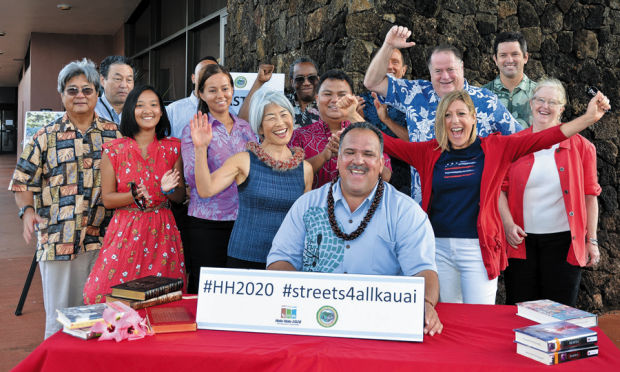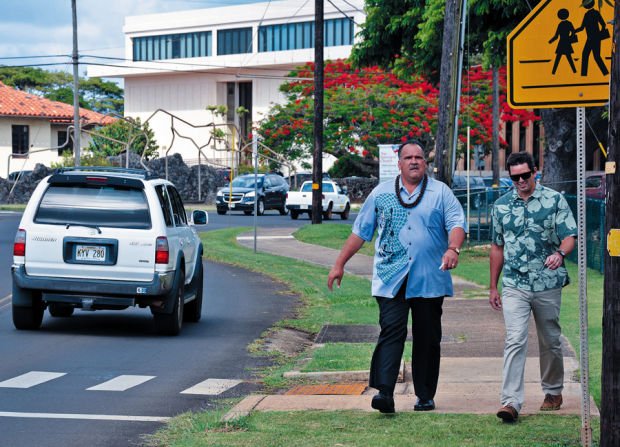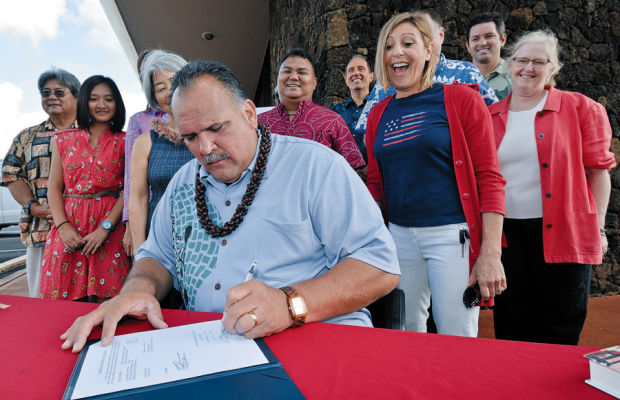Complete Streets Done Deal
Change is not easy, but it is inevitable. For many years Kauai Path has been aggressively advocating for improved walking and safer bicycling infrastructure for Kauai, Hawaii, and the nation.
At times our vision for a healthy Kauai leads to confronting those who do not see the value of building walkable and bikeable communities. While not universally endorsed (as outlined in Léo Azambuja's article below), this new Complete Streets law establishes policies supporting the environmental changes that Kauai Path strives to implement, and we regard it as a major achievement for Smart Growth on Kauai.
Sincere mahalos to Mayor Carvalho, the County Council, and the many staff and community activists who helped codify these progressive concepts into the law of the land.—Tommy A. Noyes, Secretary, Kauai Path, Inc. Board of Directors.
New law will benefit pedestrians, bicyclists on Kauai, but some Hanalei residents wary
Posted: Thursday, July 4, 2013 1:30 am Léo Azambuja - The Garden Island
LIHUE — Most parents would agree they want a safe area for their children to ride a bicycle or walk, even if it’s just to a bus stop.
A new law signed Wednesday by Mayor Bernard Carvalho, Jr. will ensure just that for future developments in new and existing subdivisions.
|
|
“This is an exciting day as we take a big step forward in our efforts to design Kauais streets with equal consideration given to all users, from pedestrians of all ages and abilities to bicyclists and transit riders, as well as motorists,” said the mayor.
The Kauai County Council unanimously approved last Wednesday the Complete Streets bill, which will set guidelines for developers to include multi-modal transportation principles in subdivisions. Developers of residential (zoned R-4 and higher) and industrial districts are now required to install sidewalks in their projects.
If the sidewalk condition is waived by the Planning Commission due to a feasibility issue or a conflict with local context and sensitivity to community character, the developer would pay a fee toward the Sidewalk/Shared Use Path Fund in lieu of the sidewalks. The bill also shortens the block length of new subdivisions from 1,800 feet to 450 feet to encourage connectivity. Creative sidewalk design is integrated by allowing drainage swales to be constructed in lieu of conventional curbs and gutters.
Bev Brody, director of Get Fit Kauai, expressed excitement about the new ordinance.
“Complete Streets is about making sure our keiki can safely walk to school, seniors have time to cross the street safely, and parents feel comfortable bicycling to a nearby park or grocery store,” said Brody. She pointed out that a comprehensive study on walkability found that residents who live in walkable neighborhoods engaged in 35 to 45 minutes of moderately intense physical activity per week, and were substantially less likely to be overweight or obese than those who live in low-walkable neighborhoods.
|
Above: Mayor Bernard Carvalho Jr. and Ian Jung of the county Attorney's Office arrive by foot for the signing of the Complete Street ordinance, Wednesday morning at the Lihue Public Library. Below: Mayor Bernard Carvalho Jr. signs the Complete Streets initiative Wednesday morning in front of the Lihue Public Library. Photos: Dennis Fujimoto | the Garden Island Newspaper
|
“Complete Streets provides opportunities for increased physical activity by incorporating features that promote regular walking, cycling and transit use on just about every street,” said Brody, noting that added benefits include the reduction of carbon dioxide and less time spent in traffic.
Although council members praised a collaboration with county agencies and Hanalei residents in crafting a final version for Bill 2465, not everyone was satisfied.
“I take it personally when government treats us as if we were stupid and we’re told that government knows better than us,” Hanalei resident Makaala Kaaumoana said.
“This is what is occurring in Hanalei because of Kauai’s Complete Streets.” Kaaumoana objected to an amendment that gives the Kauai Planning Commission the option to waive the requirement for sidewalks for developments on existing streets, and require swales instead.
The bill was amended to address concerns from North Shore resident Carl Imparato, who said the Hanalei community should have a say in keeping the town as rural as possible. Recently, the proposal to convert the former Hanalei Courthouse into a community center included tons of added concrete, according to Kaaumoana. The plan called for a 3-foot flood wall without an opportunity to follow the instructions on how to reduce runoff on the recently completed Hanalei Watershed Plan. She asked the county to stop telling the Hanalei community they are smarter than them.
Complete Streets may be a good idea for some places, but not for a community that takes care of its places, she said. “I ask for your assurances that this ordinance supports our community and others on Kauai who may feel the same,” she said. “Defend Hanalei.”
Councilman Ross Kagawa said he agrees that the government must be sensitive to the community and not force Complete Streets upon them. The government, he said, must hear the community first. And that was the council’s intent when the bill was amended last week to allow consideration from community members, he said. Kagawa’s support of the bill was for the sake and future of the children, because it will create adequate sidewalks for pedestrians and bicyclists, he said.
Councilman Mel Rapozo said he supported the bill but would be sending a request to the administration to open up dialogue for Hanalei Courthouse. “And that will be the test for me,” said Rapozo, adding he wasn’t “100 percent sold” on the bill or Complete Streets, because he thinks it comprises the rural character of some towns, such as Hanalei.
The overall intent of the bill is a good one, and it does provide for some safety measures in some areas, he said. Councilman Gary Hooser thanked the Hanalei community for their involvement, especially Kaaumoana, Carl Imparato and others who have “moved the needle up” on this issue.
The bill will bring more attention to facilities for pedestrians and bicycles, in a community that has been so “road- and car-oriented,” Councilwoman JoAnn Yukimura said. “Talking about ‘Complete Streets’ is one thing,” she said. “Actually taking action is another. It is exciting to be taking action and moving Kauai toward a safer and more walkable and bikeable community.”
There was testimony in favor of the bill from many people from Kilauea to Hanalei, according to Councilman Tim Bynum, who said changes were made after Imparato’s input.
“For me, I don’t believe that having a safe, accessible pedestrian element in a rural community destroys rural character,” he said.
• Léo Azambuja, staff writer, can be reached at 245-0452 or lazambuja@thegardenisland.com
- Login to post comments


